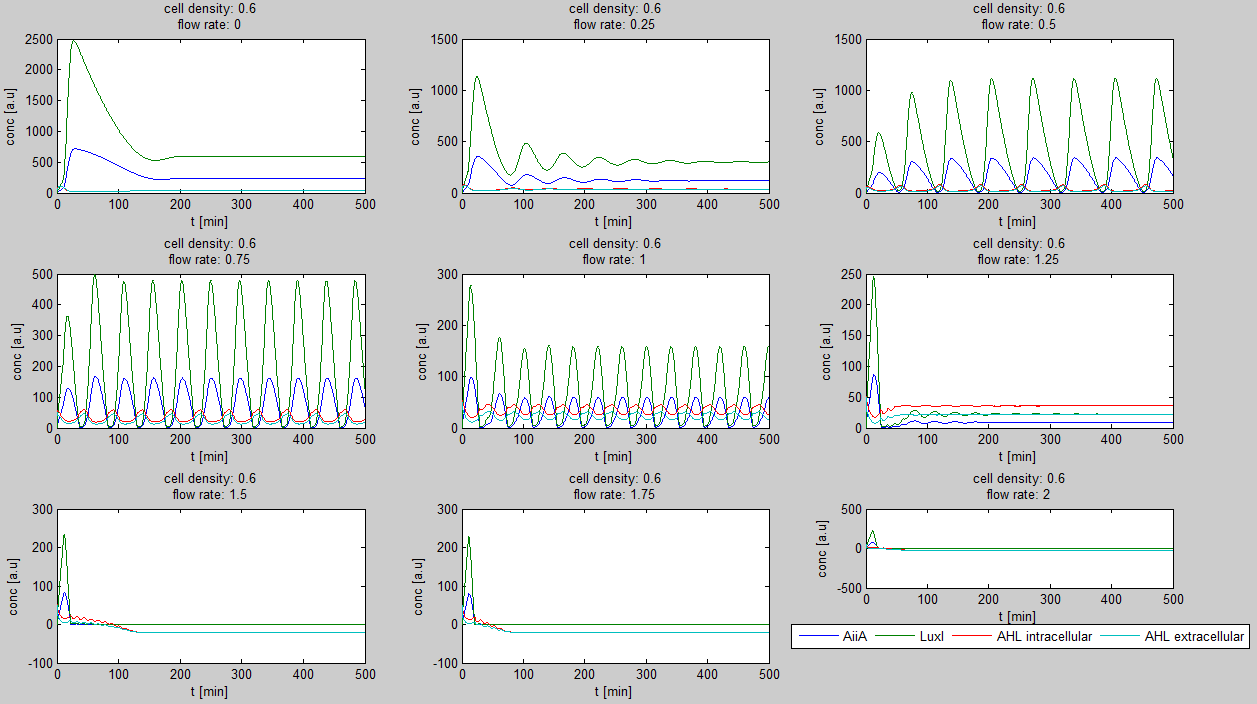Team:Wageningen UR/Project/ModelingProj1
From 2011.igem.org
(→Modeling synchronized oscillations) |
(→Modeling synchronized oscillations) |
||
| Line 38: | Line 38: | ||
The genes luxI and aiiA can be expressed when a AHL-LuxR complex binds to the promoter region. The circuit uses both a positive and negative feedback loop to control the AHL concentration and therefore the expression of the resulting proteins LuxI and AiiA. In the positive loop, LuxI generates more AHL, which, together with LuxR, can form more of the activating AHL-LuxR complex and therefore stimulates even more production of LuxI and consequently AHL. This complex also activates the expression of aiiA. In the negative feedback loop, AiiA degrades the AHL produced. For more detailed information about the circuit read more about the [[Team:Wageningen_UR/Project/CompleteProject1Description#2._Mechanism| mechanism]] in the [[Team:Wageningen_UR/Project/CompleteProject1Description| complete project description.]] | The genes luxI and aiiA can be expressed when a AHL-LuxR complex binds to the promoter region. The circuit uses both a positive and negative feedback loop to control the AHL concentration and therefore the expression of the resulting proteins LuxI and AiiA. In the positive loop, LuxI generates more AHL, which, together with LuxR, can form more of the activating AHL-LuxR complex and therefore stimulates even more production of LuxI and consequently AHL. This complex also activates the expression of aiiA. In the negative feedback loop, AiiA degrades the AHL produced. For more detailed information about the circuit read more about the [[Team:Wageningen_UR/Project/CompleteProject1Description#2._Mechanism| mechanism]] in the [[Team:Wageningen_UR/Project/CompleteProject1Description| complete project description.]] | ||
| + | |||
| + | |||
[[Team:Wageningen_UR/Project/ModelingProj1#Modeling_synchronized_oscillations| back to top]] | [[Team:Wageningen_UR/Project/ModelingProj1#Modeling_synchronized_oscillations| back to top]] | ||
| Line 89: | Line 91: | ||
'''Fig.2:''' ''Variation of output graphs depending on the different starting conditions'' | '''Fig.2:''' ''Variation of output graphs depending on the different starting conditions'' | ||
| + | |||
| Line 97: | Line 100: | ||
The first observation from the model was that, for oscillations to occur, the flow rates may not be too fast, especially at lower cell densities. Since the device used for our system has larger dimensions than the microfluidic device used by Danino et al. the flow rates in the velocities required could not be achieved by varying height differences alone. Further information can be found in the information about the [[Team:Wageningen_UR/Project/Devices| devices.]] | The first observation from the model was that, for oscillations to occur, the flow rates may not be too fast, especially at lower cell densities. Since the device used for our system has larger dimensions than the microfluidic device used by Danino et al. the flow rates in the velocities required could not be achieved by varying height differences alone. Further information can be found in the information about the [[Team:Wageningen_UR/Project/Devices| devices.]] | ||
| + | |||
| + | |||
[[Team:Wageningen_UR/Project/ModelingProj1#Modeling_synchronized_oscillations| back to top]] | [[Team:Wageningen_UR/Project/ModelingProj1#Modeling_synchronized_oscillations| back to top]] | ||
| Line 108: | Line 113: | ||
Since the lacI repressed hybrid promoter used for this system was designed by the [http://parts.mit.edu/igem07/index.php/Tokyo/Works Tokyo iGEM 2007] team, the equations were derived according to their model. The tetR repressor was then modeled using the same template. | Since the lacI repressed hybrid promoter used for this system was designed by the [http://parts.mit.edu/igem07/index.php/Tokyo/Works Tokyo iGEM 2007] team, the equations were derived according to their model. The tetR repressor was then modeled using the same template. | ||
| + | |||
| + | |||
[[Team:Wageningen_UR/Project/ModelingProj1#Modeling_synchronized_oscillations| back to top]] | [[Team:Wageningen_UR/Project/ModelingProj1#Modeling_synchronized_oscillations| back to top]] | ||
}} | }} | ||
Revision as of 19:47, 18 September 2011
 "
"






